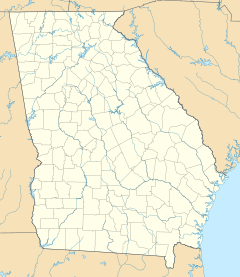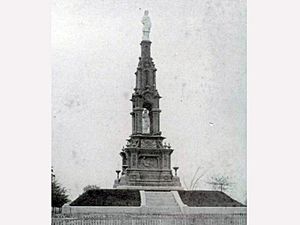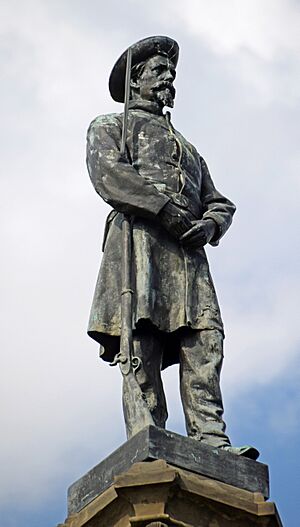Civil War Memorial (Savannah, Georgia) facts for kids
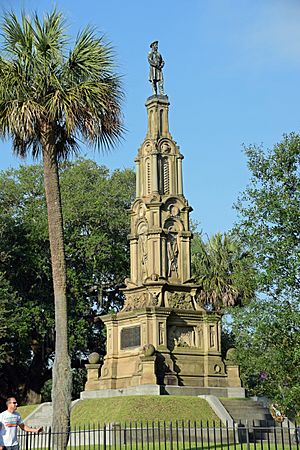
Civil War Memorial in Forsyth Park (2015)
|
|
| Coordinates | 32°4′2.0388″N 81°5′46.7808″W / 32.067233000°N 81.096328000°W |
|---|---|
| Location | Forsyth Park, Savannah, Georgia |
| Designer | Robert Reid David Richards (Confederate Soldier statue) |
| Material | Sandstone Bronze (statue) |
| Height | 48 feet (15 m) (Not counting base or top statue) |
| Beginning date | June 16, 1874 |
| Dedicated to | Confederate soldiers who died in the Civil War |
The Civil War Memorial in Savannah, Georgia is a monument that honors soldiers who died during the American Civil War. It is located in Forsyth Park. The monument has a tall shaft that is 48 foot (15 m) high. On top of the shaft is a bronze statue of a Confederate soldier.
Two other statues of important Confederate army officers stand near the monument. A fence protects the area. This monument was first called the Confederate Monument. It was dedicated in 1875 to honor Confederate soldiers who died in the Civil War. In 2018, the city of Savannah changed its name to the Civil War Memorial. This happened after a large public gathering in another city. The monument is one of the oldest and largest Confederate monuments in Georgia.
Contents
History of the Monument
How the Monument Started
The idea for a public memorial in Savannah, Georgia began in 1869. This was after soldiers killed at the Battle of Gettysburg were moved to Laurel Grove Cemetery. After this, the Ladies' Memorial Association in Savannah started raising money. They held events like bake sales and collected almost $25,000.
The association first wanted the monument in Laurel Grove Cemetery. But they decided to put it in Forsyth Park instead. Many people disagreed with this choice. They said Forsyth Park was too far from the city center back then. However, the association believed the monument would be hidden by trees and buildings in other city squares. A public meeting in May 1874 decided that Forsyth Park was the best place.
The association wanted an architect who was not from the northern states. So, they chose Robert Reid, a Welsh-born Canadian architect. In April 1873, Reid visited Savannah and agreed with the Forsyth Park location.
On June 16, 1874, the cornerstone for the monument was laid. This was part of a big festival that also raised more money. Reid had a lot of freedom in his design. The association only asked for a "life-sized figure worthy of the honor and respect due the common Confederate soldier."
To avoid using materials from northern states, the monument was built with sandstone from Nova Scotia. It was built in Canada. By the fall of 1874, the monument was finished. It was shipped from Canada to Savannah on a British schooner. This avoided transporting it through northern states.
The ship arrived in Savannah on December 25, 1874. But there was a problem with customs, which delayed moving the monument to the park. By March 1875, most of the monument was put together. On May 24, 1875, a dedication ceremony was held. Many people attended, and several famous Confederate generals were guests.
The monument had a 48 foot (15 m) shaft on a 6 foot (1.8 m) dirt base. On top of the shaft was a life-sized statue of a woman named Silence. At the bottom of the monument was another statue of a woman called Judgment. Both statues had been shipped from New York City.
Even with all the excitement, people soon started to dislike the monument. Many felt it was too fancy to represent a common soldier. Years later, Savannah mayor and historian Thomas Gamble called it "a distinct disappointment." He said it was "too symbolic" and "lacking in charm."
The Confederate Soldier Statue
In early 1878, a well-known Savannah citizen named George Wymberly Jones De Renne suggested a change. He offered to pay to replace Silence with a bronze statue of a Confederate soldier. The Ladies' Memorial Association agreed in March and April.
De Renne then hired David Richards, an architect from New York, to create the statue. This new statue was simply called Confederate Soldier. De Renne and Richards wanted to show a soldier who looked tired from battle. This was unusual at the time, as few Confederate monuments showed soldiers this way.
Former Confederate Captain Hamilton Branch helped Richards. He sent Richards clothes he wore in battle and a rifle. Branch said the clothes showed a soldier "as he looked when he marched and fought." The statue showed the soldier in a "parade rest" pose. De Renne said this pose showed "submission to the inevitable," but also a "manly struggle." Richards used photos of Savannah veteran A. S. Bacon as a model.
On May 22, 1879, the Confederate Soldier statue was lifted onto the shaft. The statues of Silence and Judgment were removed. Silence was moved to the Confederate section of Laurel Grove Cemetery. Judgment was sent to Thomasville, Georgia, for their Civil War memorial.
Other Statues Added
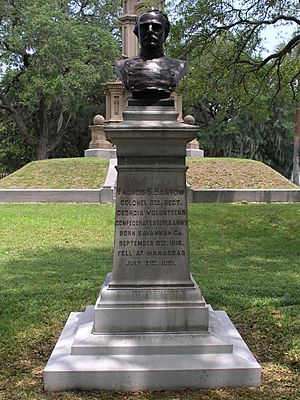
In 1910, two statues honoring Confederate generals were moved next to the monument. These busts (head and shoulders sculptures) of Lafayette McLaws and Francis S. Bartow were moved from Chippewa Square. They were moved to make space for the James Oglethorpe Monument.
Renaming and Changes
After a large public gathering in Charlottesville in 2017, the City of Savannah created a special group. This group, called the Confederate Memorial Task Force, started on October 30, 2017. The task force studied the monument's history, looked at the site, and asked the public for their opinions.
On December 22, 2017, they shared eight suggestions. The city council approved these suggestions on February 14. The plans included moving the two busts to Laurel Grove Cemetery. They also suggested changing the monument's name from "Confederate Monument" to "Civil War Memorial." A bronze plaque was also planned. It would say that the memorial was first built in 1875 for Confederate soldiers. It was redesigned in 1879 and rededicated in 2018 to honor all who died in the American Civil War.
On April 26, 2019, Governor Brian Kemp signed a new law, Georgia SB77. This law said that a monument cannot be moved to a museum, cemetery, or mausoleum unless it was originally placed there. This law stopped most of the task force's plans.
On June 18, 2020, the Savannah - Chatham County Historic Site and Monument Commission held a special meeting. They voted to send a letter supporting the task force's ideas and asking for money to make the changes.
Vandalism Incidents
On June 10, 2020, during protests happening across the country, the bust of McLaws was vandalized. A white hood was placed over the bust, and a raised fist symbol was spray-painted on its base. After this, a family member of McLaws offered to buy the statue and remove it from the park.
About a month later, on July 9, the Silence statue in Laurel Grove Cemetery was also vandalized. The words “Silence- No More” were spray-painted on it. In late September, the main monument, the busts, and the nearby sidewalk were spray-painted again during other protests.
Images for kids
-
Bust of Francis S. Bartow, with the Confederate monument in the background
See also
 In Spanish: Monumento conmemorativo de la Guerra Civil (Savannah) para niños
In Spanish: Monumento conmemorativo de la Guerra Civil (Savannah) para niños


